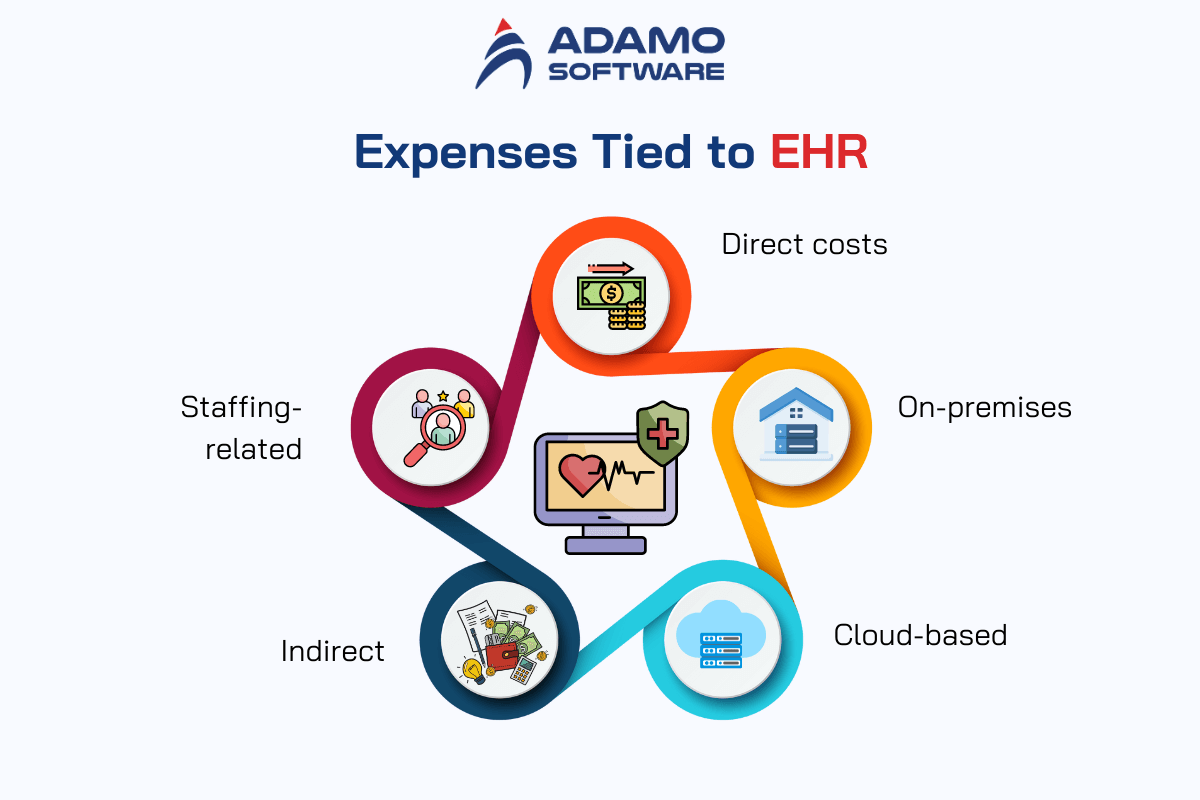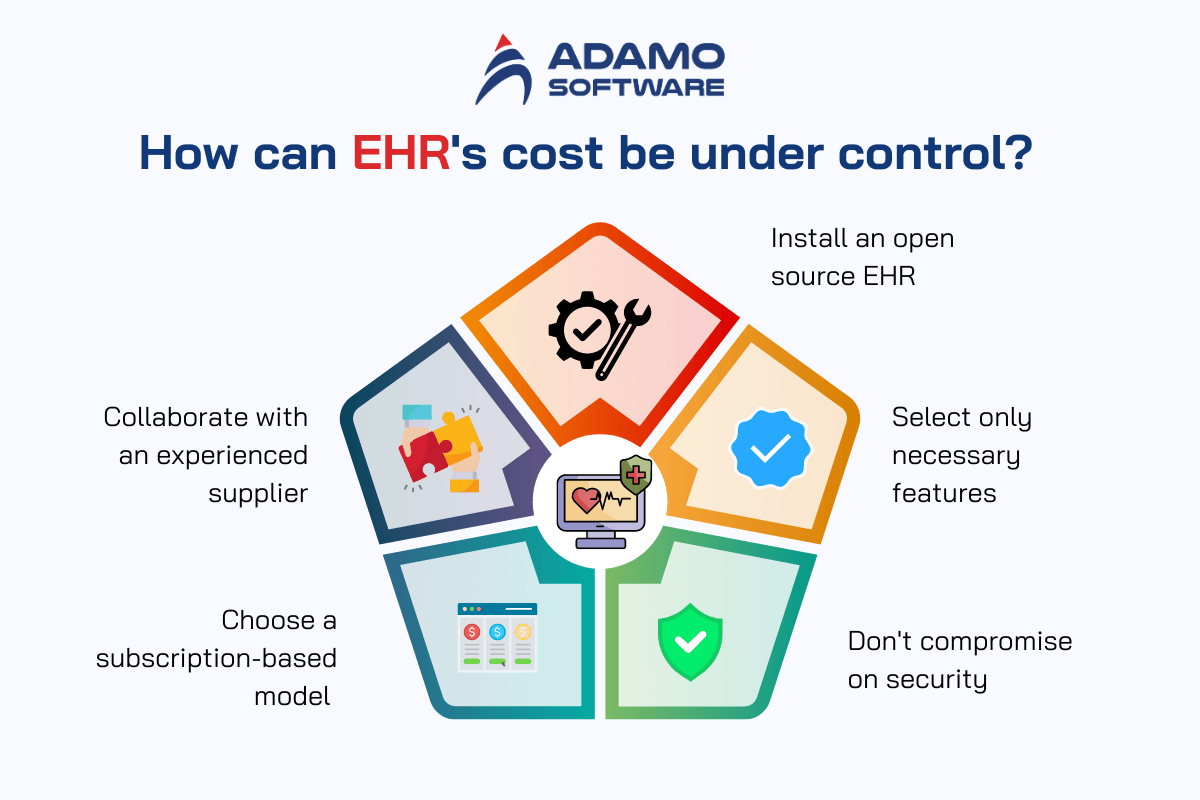EHR Integration Services: Features and costs breakdown

Technology has revolutionized the way we live, and the chaos of paperwork is over. EHR software has become commonplace and has changed how healthcare providers deliver patient care. You no longer have to carry a stack of medical reports and prescriptions to every hospital visit. However, whenever a healthcare provider talks about implementing an Electronic Health Record (EHR). The first question that comes to mind is, how much does an EHR integration services cost?
Implementing the best EHR for a single practice or hospital chain is not that complicated. However, cost is one factor that can often be a barrier. The cost of implementing an EHR can be broken down into parts based on the provider’s needs. Many physicians think an EHR is a one-time investment, but we’ve uncovered the reality through logistics and cost analysis that you might not expect.
In this article, we will explore the factors involved in the cost of an EHR integration service as well as the custom EHR integration services costs.
I. Regulatory Requirements for EHR Implementation
When considering the estimated cost of implementing an EHR, you may focus on the obvious expenses, such as software and hardware. But have you ever considered the regulatory requirements that come with implementing an EHR? The truth is these regulations play a significant role in the overall cost of using and implementing an electronic health record.
1. HIPAA Compliance
The Health Insurance Portability and Accountability Act (HIPAA) establishes a mandatory standard for safeguarding patient health information. Healthcare providers must implement multiple safeguards to maintain the confidentiality, integrity, and availability of patient information. This commitment extends beyond mere legal compliance to fostering trust with patients. Would you be comfortable sharing your health details with a provider lax about security?
2. Meaningful Use
The Meaningful Use program, initiated by the Centers for Medicare and Medicaid Services (CMS), goes beyond a simple buzzword. It offers incentives for healthcare providers to integrate and actively use certified EHR technology, thereby improving patient care. Providers aiming for these incentives need to adhere to specific criteria, including electronic management and sharing of patient data and the application of clinical decision support tools.
Regarding interoperability, consider the Health Level Seven International (HL7) standards. These standards aim for a world where EHR systems seamlessly communicate, ensuring efficient data transfer. The result? Improved coordination of care and enhanced outcomes for patients.
Thus, compliance with these standards is essential. Because it’s not only to avoid financial penalties and legal issues but also to provide superior patient care. Remember, adhering to these regulations can significantly influence the financial planning required for EHR software investments.
You can explore more about What is EMR in Healthcare: Types, Features, Cost here.
II. Exploring the expenses tied to Electronic Health Records (EHR)
One significant hurdle for healthcare organizations is the financial burden associated with the adoption of EHR integration services. However, this initial investment often leads to increased revenue over time. Selecting EHR integration services requires careful planning and consideration of various factors.
To understand the EHR implementation cost breakdown, let’s evaluate expenses tied to electronic health records:

1. Direct Costs
According to a study by Health Affairs, a typical multi-physician practice is estimated to spend about $162,000 on EHR implementation. There is an additional $85,000 in first-year maintenance costs. These figures originate from earlier phases of EHR adoption. Nonetheless, they still provide a useful guideline for what new adopters might expect about financial outlay.
Over time, practices that have implemented an EHR system are likely to recover their initial costs in roughly two and a half years. Then, enjoying an average of approximately $23,000 in net benefits annually per full-time employee.
The cost of EHR integration services can vary significantly based on several factors. Including the method of deployment chosen, whether it be an on-premise or a cloud-based system. Each choice has its own financial consequences.
2. On-premises
Opting for an on-premises EHR integration services means that the healthcare provider hosts the solution on their servers. This approach requires the purchase of a perpetual license, usually entailing a substantial upfront cost.
Operating an on-premises EHR involves managing all the back-end technology necessary for running the system. Includes robust servers, reliable data backup systems, sufficient data storage, and possibly additional technological infrastructure.
3. Cloud-based
One of the common deployment options is cloud-based. This cloud-based EHR system stores the provider’s data on the vendor’s servers, with access facilitated through the Internet. This model generally incurs a recurring subscription fee, payable monthly or annually. You may pay upfront costs, but they are typically less than those associated with on-premises systems fees.
With a cloud-based solution, the vendor handles the hosting responsibilities. You don’t need to lay out money for extra servers, storage, or data security measures. However, the number of employees who can use the software may be restricted. Additionally, if more users need access, the subscription fee may increase.
Cloud-based solutions are typically less expensive, with fewer upfront costs. However, the benefit to specific medical facilities varies based on factors like clinic size, number of physicians, and physician preference.
4. Indirect
When considering the costs of EHR integration services, it’s important to look beyond just the initial setup and ongoing fees. Indirect costs associated with EHR integration services also play a major role in the overall financial commitment required for implementation.
One critical area often overlooked is the budget for EHR training. Adequate training for your physicians and staff might seem costly. You should save on this essential expense. Because it can lead to greater costs down the road as your team struggles with the new system. It’s crucial not to cut corners on thorough training, as it pays off by preventing costly mistakes and inefficiencies.
Remember that productivity typically declines temporarily right after implementing an EHR system. Medical staff will need time to adjust to the new software, which can slow down their usual pace of work. This adjustment period is often unavoidable if you want to ensure they are fully competent with the system and not making errors.
It is typical for doctors to handle one fewer patient per day during the first six months after switching to EHR integration services. However, you can expect productivity to return to normal or even improve once this initial phase is over. It’s crucial to plan for both the best and worst outcomes by assessing how this change might financially affect your practice’s efficiency.
A recurring challenge with EHR integration services is the issue of system downtime. Because it often occurs without prior notice due to maintenance or updates. These unexpected downtimes can disrupt clinical operations significantly, especially if they happen suddenly, without any alerts to the practice. Such incidents can thrust the entire operation into an offline mode. Causing not just operational disruptions, but also potentially severe repercussions for patient care and practice workflow.
In-depth studies on EHR integration services downtimes reveal that these disruptions often occur unexpectedly and without warnings. It can severely impact the functionality of healthcare practice.
5. Staffing-related
Another important factor is staffing-related. You can determine how much you’ll need to adjust your IT staff once the EHR software is operational. Even practices with minimal IT demands should evaluate the necessity for additional IT support during the implementation phase.
Most medical practices must ensure that certain IT resources. For example, practice management software or email servers are operational 24/7, and maintaining these systems requires significant effort. Although many cloud-based providers offer technical support, on-premises solutions generally necessitate having a dedicated IT team.
If you think your IT team might be stretched too thin, consider the following steps:
- Allocate funds for temporary IT assistance.
- Implement routine maintenance for on-premises EHR systems.
- Consider bringing in a temporary physician or clinician to keep up with patient care.
- Ensure sufficient support is available for a seamless EHR rollout.
- Prepare for potential challenges to avoid any disruptions.
- Expect the Unexpected
Lastly, it is crucial to anticipate unexpected costs that may arise during EHR implementation. Identify possible challenges and evaluate your circumstances appropriately. While it’s impossible to foresee all implementation costs, adhering to these guidelines can help avoid unexpected expenses after purchase.
III. Hidden costs of implementing EHR
Implementing EHR integration services involves more than just the visible expenses of software and setup. In this section, we will examine the hidden costs associated with EHR implementation and offer guidance on how to plan effectively.
1. Data migration
When adopting EHR integration services, be aware of potential hidden costs linked to healthcare data migration. This process involves moving patient records and clinical information from old systems to the new EHR platform. To facilitate a seamless transition, investments might be necessary for data migration tools and the hiring of specialized personnel. A certified EHR developer can help customize your solution, ensuring the accuracy and integrity of the data transferred. The cost of migrating data to EHR integration services can range significantly based on data volume and complexity. The diversity of the data formats, with estimates ranging from $5,000 to over $150,000.
2. Integration with other systems
Integrating your new EHR integration services with existing healthcare applications may lead to additional costs. Including customization, integration of healthcare APIs, and testing to confirm effective interoperability. EHR integration services can integrate with various software, including:
- Remote patient monitoring software development
- Healthcare CRM implementation
- Patient portal development
- Telemedicine software development
- E-prescription app development
- Laboratory information management systems
- Radiology information systems

EHR developers can offer assistance in creating custom interfaces or connectors to streamline data exchange between these systems. The costs for EHR integration services depend on the complexity of your requirements and can range from $5,000 to over $200,000.
3. Software Licensing
While initial software licensing fees might seem clear, hidden costs in EHR implementation could stem from additional modules, user licenses, or ongoing subscription fees. Additional expenses may also include charges for license upgrades, maintenance contracts, and vendor-specific functionality fees. EHR developers can provide insights into the best licensing options and help minimize your software expenses.
Overall, expenses related to software licensing could total between $10,000 and $100,000+ throughout the system’s lifecycle.
4. Regulatory Compliance
Complying with regulations like HIPAA, GDPR, HITECH, FDA, and PIPEDA ensures data privacy, security, and proper EHR usage. It also requires the approval of medical devices. Compliance may necessitate risk assessments, encryption, staff training, and the maintenance of audit trails.
Compliance adjustment costs can vary widely. They are starting from approximately $5,000, depending on the specific regulatory requirements relevant to your organization.
IV. How can EHR’s cost be under control?
An EHR development plan for a healthcare organization revolves around analyzing costs and benefits while emphasizing cost control. While EHR systems offer many benefits, evidence has shown that organizations tend to recoup implementation costs after two to three years.
Healthcare providers highlight budget constraints as a factor hindering the digitalization of healthcare. To control costs, doctors participating in the implementation provided many comments. These will also help reduce EHR costs for private practices and large hospitals.

1. Install an open source EHR
Using open-source EHR integration services may result in a user interface that is not fully supported. However, it is capable of providing essential functions at minimal cost or completely free of charge. Sometimes, healthcare organizations lack the IT expertise to use open-source implementations or need additional features. Partnering with a developer can be a more economical alternative to choosing proprietary EHR integration services.
2. Select only necessary features
Before making a decision, the first thing to do is to carefully analyze the market to understand the costs of electronic health records in detail. This helps identify the critical functions a healthcare organization needs to operate smoothly. Selecting features and integrations is the right approach to avoid unnecessary costs. This approach helps optimize costs, ensures the right EHR integration services are selected, and provides the option to scale over time.
3. Don’t compromise on security
Medical data is highly sensitive and confidential, making its protection a top priority for healthcare companies, especially when considering cost-cutting strategies for EHR implementation. In the healthcare sector, data breaches are not only common but also extremely costly, both financially and in terms of reputation. Opting for a cheaper EHR system with inadequate security features may seem like a way to reduce expenses initially.
However, the long-term consequences, including potential fines, legal actions, and loss of patient trust, could far outweigh the upfront savings. Investing in a more premium, secure solution is often the smarter choice, ultimately protecting both data and finances.
4. Choose a subscription-based model
Solutions that support annual subscription payments are an excellent option for healthcare organizations looking to manage upfront costs more effectively. While this approach may result in a higher total cost of ownership over time, it provides valuable flexibility. Companies can easily modify or upgrade their service packages as their needs evolve, making it easier to adapt to new requirements.
This flexibility also helps organizations better manage their budgets by accounting for unforeseen costs, reducing the risk of financial strain, and enabling necessary adjustments without significant disruption to their operations.
5. Collaborate with an experienced supplier
Experienced EHR integration companies are eager to demonstrate their effectiveness in implementing EHR optimally. Therefore, they can help healthcare organizations optimize costs by identifying areas that need attention.
These companies provide skilled teams to accelerate implementation, help reduce project costs, and quickly leverage system benefits. This approach is important for maximizing cost-effectiveness and taking full advantage of the benefits of the EHR integration services.
V. Custom EHR integration services costs
Due to the diversity of medical specialties, each healthcare practice requires a system designed specifically for its unique needs. Some practices may need remote patient monitoring or telehealth capabilities to deliver virtual care, and medical billing systems to handle reimbursements.
While general practitioners and hospitals might find off-the-shelf EHR integration services sufficient, specialized practices may need more. Pediatric clinics, surgical centers, mental health facilities, and hospices benefit from customized EHR integration services tailored to their specific services.
The cost of EHR deployment varies significantly across different providers, typically ranging from $50,000 to $500,000. It depends on the number of features and integrations required. Investing in custom EHR integration services may seem expensive initially, but it can ultimately lead to substantial long-term savings for the practice.
VI. Why Choose Adamo as your EHR integration vendors?
To sum up, implementing an electronic health record (EHR) is a complex process that involves many costs. So, if you want to set up an EHR interservice, you need to consider choosing a trusted healthcare software development vendor.

As a premier software development company in Vietnam. Adamo’s developers are not only well-versed in healthcare regulations, ensuring that your EHR system meets all regulatory standards. We are also skilled in using the latest technologies to create advanced EHR integration services as your trusted EHR integration vendors.
At Adamo Software, we possess the perfect mix of skills and technological expertise to develop and deploy an effective EHR for your healthcare system. We ensure high security, scalability, and interoperability. And now, simply contact our healthcare specialists to begin your EHR journey.











